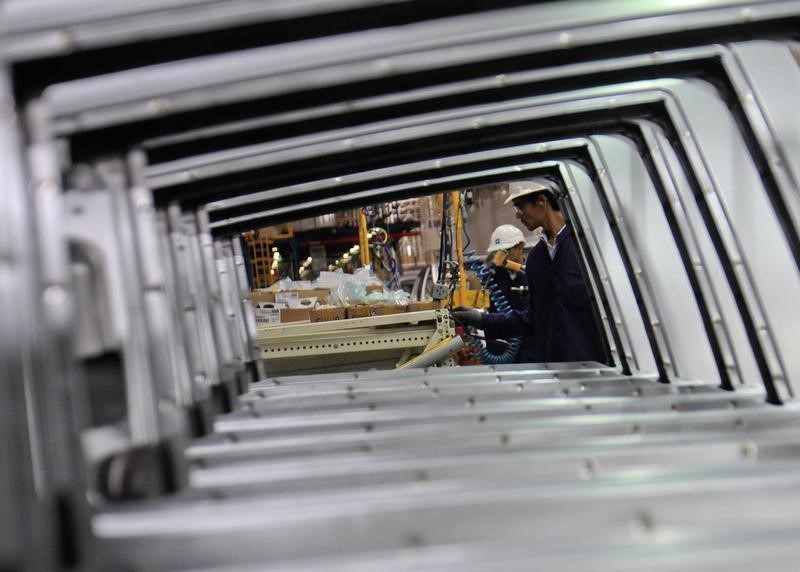The cycling sailors: Meet the pedal-pushers who keep the high-tech America’s Cup yachts flying
BARCELONA, Spain (AP) — Pounding on the pedals tucked inside his cockpit, David “Freddie” Carr is helping to keep Britain’s yacht flying over the Mediterranean waves at the 37th America’s Cup.
Carr is a member of the select tribe of cyclors, the “cycling sailors” almost hidden in the hulls of the powerful AC75 foiling yachts. These human workhorses use their strength and endurance to generate the hydraulic power needed to trim the sails and rotate the masts of their super-fast boats during the 20-minute-plus races.
If the cyclors’ legs tire, the multimillion yachts can be left flailing as a rival cruises away.
“I honestly think it is probably one of the more extreme sporting environments that’s ever existed,” Carr tells The Associated Press after a recent race. “I’ve been racing America’s Cups for 20 years, so I’ve kind of been all the way through from early grinding into winches into this now. And it’s not just the physical effort that you have to do. You have to stay switched on cognitively to kind of help sail the boat.”
The efforts of Carr and his crewmates have put INEOS Britannia into the challengers final against Luna Rossa Prada Pirelli starting on Thursday off Barcelona. The winner will get a shot at defending champion Team Emirates New Zealand for the biggest prize in sailing.
Carr described what it is like to be mounted on a stationary bike inside a nearly airborne yacht: Your heart is pounding, you are hot and facing G-forces on the sharp maneuvers, you have to process data from a screen, all while “building a tactical picture in your head” because you are blind to the action.
“It is bizarre, unlike any other sailing I’ve done previously,” Carr says. He knows how far the racing has evolved over the past two decades.
This is America’s Cup No. 6 for Carr.
At age 42, he has seen firsthand the incredible transformation of America’s Cup yachts from the typical mental image of what most people have of a sailboat to its current iteration that looks like a giant mechanical water-skimming insect — that, or a spaceship — with a mast and sails sticking out of the top.
Carr is a native of the Isle of Wight, where the America’s Cup started in 1851. The Englishman started racing on relatively traditional monohulls that went 10 mph (16 kph). The AC75s now regularly hit 60 mph (100 kph).
But he has adapted to the changes in design that have also impacted the jobs of the crew, shifting from using his arms to his legs.
Carr was there when cyclors were first introduced at the 2017 America’s Cup in Bermuda. And when they were dropped again in the 2021 edition in Auckland in favor of a return to the hand-powered grinders who spun winches. But with the 2024 organizers wanting to cut the weight of the boats, four cyclors are back as crews were reduced from 11 to eight members.
In constant search for improved aerodynamics, the crew are inside their own cockpits. And while the helmsmen peek out to steer, the cyclors are heads down out of the airstream.
And for Carr, that means the sport he loves has lost a little bit of the human element and physical camaraderie that he so much enjoyed.
“You don’t have any visual contact with anybody else, so you are solely relying on your communication from your earphones and the data in front of you,” he says. “You used to do a lot of that with sort of nonverbal communication, body language with a wink, a flick of the elbow or something like that. And trying to adapt to being in your own little world, relying solely on verbal communication that you’re getting through your headset, is really big.”
Keeping mentally composed as a team plays directly into the grueling physical demands of the job, since, Carr says, “The skill in being a cyclor is recognizing the moments where you can have a breather.”
As the boost in the role of data-driven technology has led to the specialization of the cyclor role, the gangway has been lowered to let non-sailors onto the fastest yachts in the world. Several athletes with rowing and cycling backgrounds are among the America’s Cup crews.
So Carr and his fellow sailors have had to welcome and train new teammates who, at least compared with them, are pretty much landlubbers.
“There is a group of new lads that have come in who can’t sail, effectively,” he says. “We’ve had to be very open-minded to upskill these guys. … (because a) team starts falling down when you’ve got little cliques, little nooks, little subcultures within it. And we’ve worked really hard to just stop that from happening.”
At least he can swim
Carr’s Britannia crew is in no way alone in having relative newcomers to sailing among its cyclor unit.
American Magic, the boat representing the New York Yacht Club that was eliminated by Luna Rossa last week, even featured a swimmer in Colton Hall.
Hall says what he could give in watts over the long haul earned him a spot on American Magic. The rest has been a quick learning experience.
“It’s unlike anything I’ve ever done before,” Hall tells the AP. “You don’t really even feel like you’re on a boat because you’re protected by the wind. You’re rarely getting wet if the sailors are doing a good job. You’re going fast, but to be honest, I can’t really tell the difference between going 10 knots and when we’re going 50.”
Hall had excelled as a swimmer and transitioned into cycling when he was steered toward a tryout session for American Magic.
“When I told my parents I was trying out for a sailing team, they were like, ’You don’t know anything about sailing. What are you thinking?” Hall says. “I had to explain the whole opportunity to them. It’s been really exciting to be a part of this. It’s just all-encompassing.”
___
AP sports: https://apnews.com/sports
Related
Taiwan Semiconductor Manufacturing (TSM): Why US Tech Giants Still Rely…
We recently published a list of 10 Trending AI Stocks on Latest News and Ratings. In this article, we are going to take a look at where Taiwan Semiconductor
New US drones tested on Ukraine front line hailed as…
New advanced U.S. drone systems have been hailed as "game changers" after being successfully tested on the front lines of the war in Ukraine.Developed by two le
American Airlines expands new early boarding tech
INDIANAPOLIS (WISH) — Here’s a look at Monday’s business headlines with Jane King, who discusses new American Airlines boarding t
Labelers training AI say they’re overworked, underpaid and exploited by…
The familiar narrative is that artificial intelligence will take away human jobs: machine-learning will let cars, computers and chatbots teach themselves - maki












